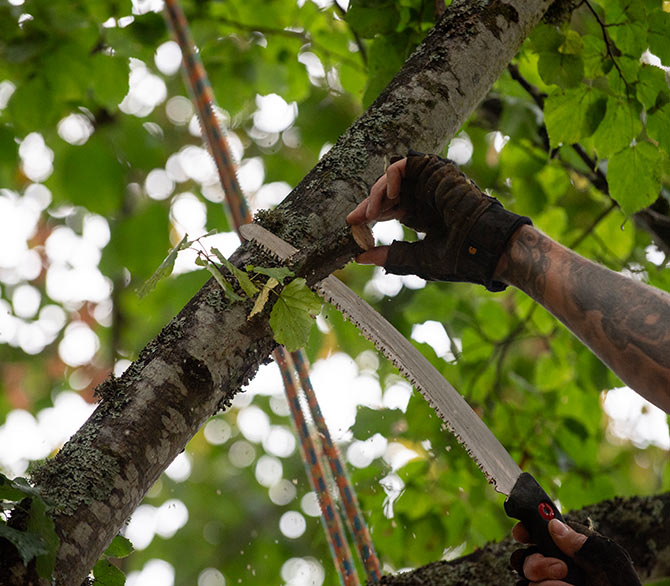A resource for trees on your property
Treesilience is a national initiative focused on supporting the health and resilience of tree canopy in areas where canopy is threatened or already lost and where neighbors stand to gain the most from more resilient urban forests. This initiative focuses on addressing community priorities and barriers related to tree canopy, ultimately supporting a healthy, resilient tree canopy where people need it most. Through the Treesilience initiative, residents can connect with resources to assess the health of one or more trees on their property and to address any health concerns – including mature tree maintenance such as pruning as well as tree removal, if needed.
Be a part of the Tacoma Treesilience Pilot
We are launching a Tacoma Treesilience pilot to support residents in evaluating and maintaining their mature trees. As part of this, we are inviting residential property owners to submit requests to receive a tree health assessment on their private property in neighborhoods with low tree equity. Through the project, residents will receive the results of the tree health assessment as well as be eligible to have the costs of the resulting maintenance covered. *Note: Trees located on the Right-of-Way or Planting Strip are not eligible as part of this project.
Do you live in the Green Blocks South End eligible area and have a tree that you would like considered for an assessment and any resulting maintenance? Please submit your interest through this form by September 21 to be considered! The Nature Conservancy will follow-up with you to confirm interest and share next steps. As this is a pilot, we have limited resources and will be only able to accept a limited number of properties into the project. We will be primarily prioritizing projects on a first come, first served basis.
The Partnership
The Treesilience Initiative is a national collaborative effort of non-profits, tree care companies, and government agencies to support place-based, community-informed efforts to address barriers to a healthy tree canopy. In Tacoma, this pilot project is being driven through a partnership of The Nature Conservancy and Tacoma Tree Foundation. Note: This program is not affiliated with the City of Tacoma or the Tacoma Community Tree Program.
Funds for this project project are provided by the USDA Forest Service Urban and Community Forestry Program, administered through the State of Washington Department of Natural Resources Urban and Community Forestry Program.
Why is this program focused on maintaining trees?
Building a healthy, resilient tree canopy goes beyond planting new trees—it includes caring for the mature canopy in our communities. Large, mature trees help produce the most benefits for the environment. By proactively caring for these trees, we can extend their life and the benefits they are providing to our community. Trees also have a limited life span, at times impacted by the environment and disease. Removing these dead and dying trees that are no longer producing ecosystem services and contributing to the health of the community makes space to plant new trees.
However, it can be challenging to connect with the expert arborists who can evaluate the health of the tree and recommend a maintenance strategy—and the resulting costs of that maintenance can be high.
Treesilience is focused on reducing both of these barriers by connecting homeowners from overburdened communities with professional arborists and financing the resulting tree care – including, at times, the removal of dead and dying trees.
Check out this video from St. Louis that provides a look at their Treesilience program.
FAQs and other resources
Who is eligible?
Currently, eligibility for this pilot program is limited to homeowners located in the Green Blocks: South End project area. Trees must be located on your property. Trees located on the Right-of-Way / Planting Strip are ineligible for this project.
Can I submit my neighbor's tree for consideration?
If you think your neighbor’s tree might be a good fit for a Tree Health Assessment and related maintenance – consider sharing this opportunity with them and sharing the benefits of proactively maintaining our urban tree canopy to support ecosystem and community benefits.
Why are these geographies prioritized?
Green Blocks is a program led by the Tacoma Tree Foundation to plant trees in the public right of way in areas that experience low tree canopy throughout the Tacoma area. Green Blocks: South End is part of the Community Tree Program, a partnership of the Tacoma Tree Foundation and the City of Tacoma. The South End project area falls with census blocks identified as priority by the City of Tacoma’s Tree Planting Priority Tool. This tool incorporates City-wide data such as Tacoma’s Equity Index, Urban Heat Island temperature distribution, existing tree canopy, and available planting space, to generate the planting prioritization score.
Treesilience is designed to complement these important tree planting efforts, to support an overall healthy, resilient community canopy that supports benefits for people and ecosystems.
What happens after I submit my interest form?
After you submit your interest form, The Nature Conservancy—in partnership with Tacoma Tree Foundation—will review the request based on a first come, first served basis. We may reach out with additional questions or requests to do a brief site visit if additional information is needed before confirming your eligibility to participate in the pilot project. Following this initial assessment, you will receive an email sharing the status of your request. This status could include: 1) Added to list of tree health assessment recipients; 2) Added to a waitlist based on future available resources; or 3) Ineligible for this current offering.
How does the Tree Assessment work? What is included?
The Nature Conservancy is in the process of selecting and contracting with a Certified Arborist / Qualified Tree Risk Assessor to conduct the tree assessments on properties. These tree assessments will evaluate the tree based on a standardized and systemic process for assessing tree risk developed by the International Society of Arboriculture. This will include visual inspection of the whole tree – including potentially climbing the tree – to develop a recommended maintenance strategy.* This maintenance strategy could include tree health management such as pest and disease treatments; structural pruning and or other types of trimming; and, potentially, removal.
If you are selected to receive a tree health assessment, you will be connected to the contractor to review and sign the work order and to schedule the tree health assessment.
*For some trees, the assessor may recommend additional evaluation to understand the risk to the tree. At this time, this cannot be covered under this pilot program.
If I get a tree assessment, will I automatically receive the recommended maintenance?
No. Due to resource limitations, we may or may not be able to complete all of the recommended maintenance. The Nature Conservancy will work with the selected tree assessment contractor to prioritize the maintenance based on level of risk and cost.
Who will be performing the maintenance?
The Nature Conservancy will contract with a qualified tree care company that includes Certified Arborists on staff to oversee the maintenance. Homeowners receiving the maintenance will be able to review the qualifications of the contractor before agreeing to the work occurring on their property.
What is a “tree of concern”?
Trees of concern can come in many different forms. They could pose a risk to your house or other structures on your property as well as be diseased in ways that threaten other trees within the community. Concerns could include overgrown tree canopy; broken or dying branches; or other signs that the tree is in declining health.
What is a Certified Arborist? What should I consider when selecting an arborist?
Certified arborists are professionals that have received extensive and ongoing training in the knowledge of trees – including planting, caring, maintaining and diagnosing trees. With this base of knowledge, these professionals can assess the condition of trees and develop recommendations on how to provide proper care for your trees. Arborists can also perform tree care services.
The Pacific Northwest Chapter of the International Society of Arboriculture has developed some helpful guidance for what to consider when hiring an arborist for your property.
What can I do to support my tree without an arborist?
There are many important ways that homeowners can care for the trees on their property. This includes watering trees on their property to support establishment after planting; regularly pruning trees to support healthy growth; and proactively monitoring the tree to identify potential pests.
There are many resources to support your efforts to care for your trees. Here are a few:
If my tree is removed, can I get a replacement?
The Nature Conservancy will work with property owners to identify how to acquire a replacement tree.
In the Greater Tacoma area, there are many ways to acquire trees, including free and reduced-price trees. For an overview of current programs, visit “Trees for Greater Tacoma”.
Where can I learn more about the benefits of trees?
The Nature Conservancy has developed materials highlighting the benefits of trees, including an article on the advantages of urban trees and a one-page summary of their health benefits.
Will Treesilience be available in other areas in the future?
Currently, there are plans to offer Treesilience in one other neighborhood. The Nature Conservancy and partners are actively exploring opportunities to expand this effort to other geographies in our region. Connect with us if you are interested in learning more. And stay tuned for future project updates!
I have a question that isn’t listed here. Who can I ask?
Reach out to Hannah at hannah.kett@tnc.org if you have additional questions!

